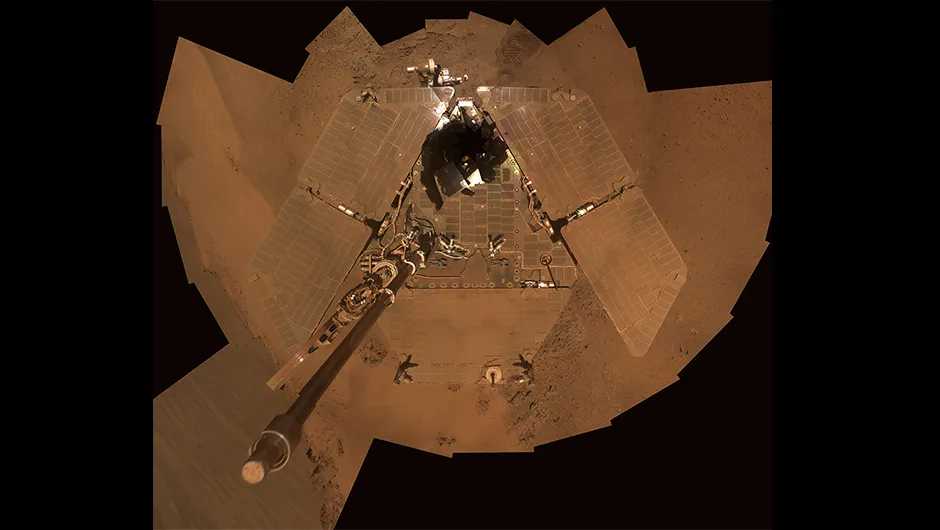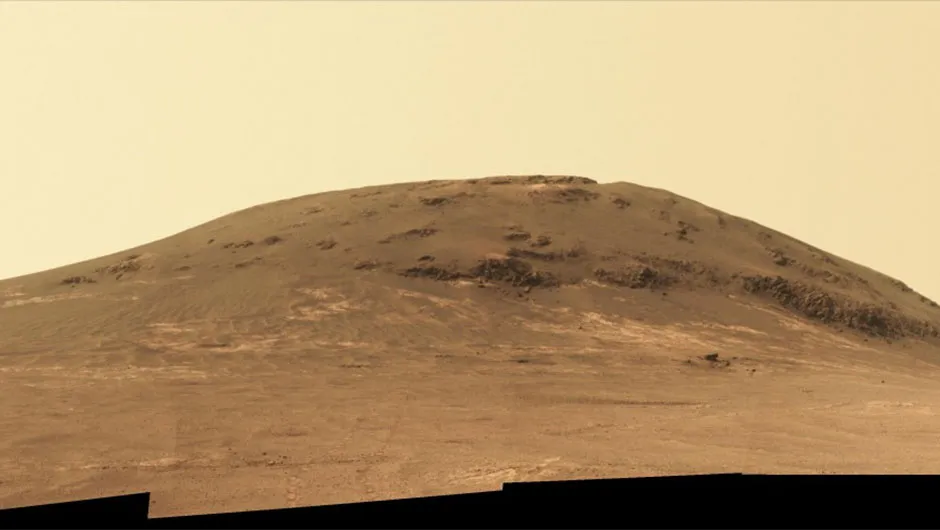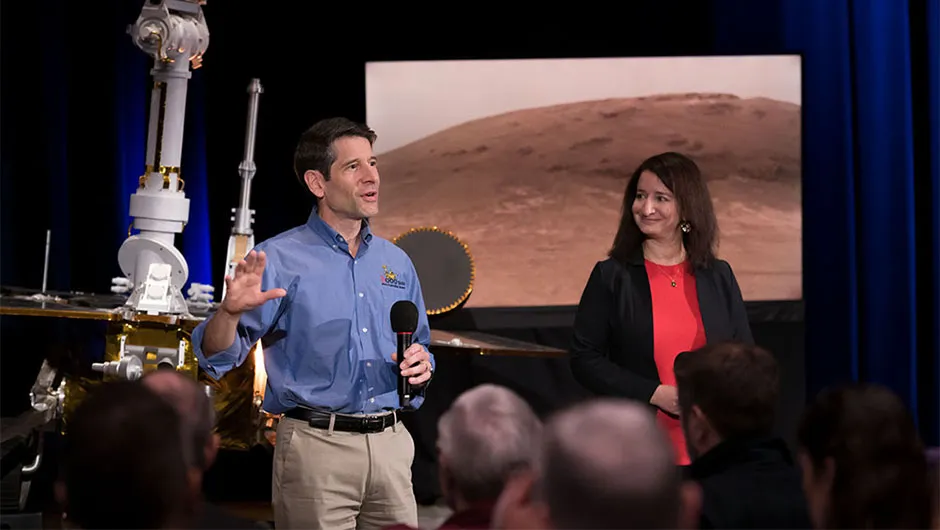On 13 February 2019, NASA announced that its Mars Exploration Rover Opportunity mission had ended. The rover spent 15 years roaming the surface of the Red Planet, collecting data and beaming it back to scientists on Earth.
We spoke to the mission's deputy project scientist Dr Abigail Fraeman to find out what it's like to drive rovers on Mars, and how it felt bidding farewell to Opportunity.
Why did NASA end the Opportunity mission?
Opportunity was supposed to last for 90 days, about three months, and we were just approaching year fourteen-and-half of the mission, so we’d been going a lot longer than we even dreamed we could.
But in June 2018, Mars experienced a global dust storm.The Red Planet gets these dust storms in the summertime every couple of Martian years, and the rover had previously survived one of them.
The one that hit this past June was so much bigger and originated almost right on top of the rover.When there’s a Martian dust storm you get a lot of dust in the air and that blocks out the sunlight.That’s a problem for Opportunity because it is a solar-panelled rover.It needs sunlight to charge up its battery.
When you have a lot of dust blocking the Sun there’s simply not enough light to charge the battery and so we slipped into a low-power fault.Once the dust storm cleared, we were hoping that we’d be able to recharge and hear from the rover.
We sent over a thousand command attempts to hear from her again, but unfortunately those were unsuccessful.There was probably still too much dust that had settled on the solar panels, or there may have been some other fault with the vehicle.
After about eight months of trying to reclaim Opportunity’s communications with Earth, we decided we’d done enough.Winter was setting in and it was time to call the completion of the mission.

There are of course other human-made orbiters and rovers on Mars. Was there a possibility of sending one to inspect Opportunity and help it out?
That would’ve been great, but unfortunately the other rover that we have operating on the surface right now is Curiosity.
That’s on the other side of the planet so it would have had to drive hundreds of thousands of kilometres to get to Opportunity and that’s just not realistic!
How do rovers actually operate on Mars, and how much control does NASA have over them once they’re roaming the planet?
We’ve sent a handful of landers to Mars and four rovers.It started with Pathfinder back in the mid ‘90s and Spirit and Opportunity in the mid 2000s.These were followed by the Curiosity rover, which is what we’re still operating today.
It’s really a lot of fun to get to drive these rovers on Mars.
The engineering team is almost all located here at NASA’s Jet Propulsion Laboratory in Pasadena, California, but we have science team members from all over the world, including many in the UK.
On a typical day of rover operations we have daily telecons in the morning where talk about what what the rover saw the previous day and we decide what we want to do, what observations we want to make, where we want to drive.
We work closely with the engineering team to make sure everything fits within the day’s allocated time and the rover’s power and data volume.We send up the plan that night, the rover does its thing and then we get the results of what happened the next morning.
We’ve been doing this for Opportunity essentially every day for about fifteen years.
What sort of work has Opportunity been doing on the Red Planet?
Opportunity and its twin rover Spirit were working as our robotic field geologists.We had science instruments on the rover that were designed to look at Martian rocks, their composition and textures.
On Spirit and Opportunity we even had a tool that grinds into the rock like a geologist’s hammer, so we could break open the rocks and expose fresh surfaces.All of these techniques are really trying to get at the question “what was Mars like in the past?”
Its history is stored in the rock record, so we’re like detectives at the scene of the crime reading the rocks to figure out, three billion years ago, what the climate of Mars was like.Was there water on the surface? What was the water like? Was it a habitable environment?
We’re interested in understanding whether life ever arose on Mars. In the past it was a very different planet than it is today. We think it had conditions that were conducive to life.
Might Mars have ever been like Earth? If so, what could have happened to make it such a barren, rocky planet?
The climate of Mars three billion years ago was probably a lot like the climate of Earth three billion years ago.Opportunity found evidence that the temperatures must have been warm enough to support liquid water that had a nice, neutral, drinkable pH.
With the Curiosity rover we’re actually driving through an ancient lake bed, so we’re seeing evidence that there was a lake on Mars three billion years ago that lasted for at least a million years, maybe even more.
Mars today is very cold and the atmosphere is way too thin to support any liquid water on the surface, so understanding how and why Mars changed is actually a really interesting question that we’re still trying to answer.
Broadly, it’s probably linked to the fact that Mars is a little bit smaller than Earth so it probably cooled off a little bit quicker.
It lost its magnetic field, it lost a lot of the heat from the interior and that cooled everything off and allowed its atmosphere to be stripped away.

It wasn’t all plain sailing for Opportunity. Weren't there were a few moments when it got stuck and almost didn’t make it out?
Opportunity got stuck in a ripple and we ended up calling it ‘Purgatory Ripple’.For a good portion of the mission we ended up driving across this sea of ripples on the surface as we were hopping from crater to crater, because they are geologically interesting.
During this really long drive we got stuck, and it took a lot of work to figure out how we were going to get ourselves unstuck. What you really don't want to do is make the situation worse!
We did a lot of work here at JPL on a test bed and we figured out that the best way to get unstuck was to just put the rover in reverse and gun it, which is what we did.
More recently we’d been having a lot of fun driving on these really steep slopes and skidding all over the place trying to drive uphill at 35° inclinations. It’s been fun.
How do you deal with a situation like that in real time? There must be a bit of a delay between you sending a command to the rover and the rover putting that command into action.
If we could talk to the rovers continuously throughout the day there would be at least a 20-30 minute delay between the time we hit ‘send’ on the commands, they get to the rover, the rover does its thing and sends information back to us.
Imagine you’re driving a really nice sports car. How would you feel if you only saw what was on the road with a 20-minute delay?That’s a tough situation so we have a lot of automation on the rover.
But it’s actually even a bit worse than that because we talk to the rovers through the NASA and ESA orbiters we have on Mars, and those only pass overhead once or twice a day.
We really only communicate with the rover at the beginning and end of the day, so in that sense we send the whole day’s plan, and there’s a lot of automation, a lot of fault protection, and after our experience in Purgatory Ripple we added checks during the drive to say to the rover “ok, you think you’ve driven a hundred metres.Have you actually driven a hundred metres or have you driven one metre?”
So the rover has automated slip detection and it will stop a drive as soon as it realises it’s slipping and getting into a dangerous situation.

In terms of the rover’s automation, does it have the ability to independently decide whether a feature or a rock on Mars is particularly interesting, and whether to investigate?
We actually have some really neat software that we introduced to Opportunity and Spirit a couple of years after the mission landed.
This is an automatic dust devil detection finder, so we can tell the rover to spend the next hour or so looking around, and if it sees any evidence that there is a dust devil spinning up, to take a picture of it so we can study it.
We have similar software on the Curiosity rover that allows it to target rocks with one of its instruments, a laser called the ChemCam, and we can actually say “hey Curiosity, find your favourite rock and shoot it with this laser so we can analyse it.”
It’s really amazing.
With the knowledge and experience we’ve gained putting rovers on Mars, could we ever put a rover on an icy moon in our Solar System, or on a different rocky planet?
I certainly hope so. Every Solar System body is going to be a little bit different for operations, in terms of the infrastructure you have in order to get the data back and the environment in which you need to operate.
But we’ve developed a strategy that we like. Fly by a body with a spacecraft, orbit the body, land and then rove.It seems to have been working out really well for Mars so I really hope we get to send rovers to other bodies in the Solar System.
A video from NASA's Jet Propulsion Laboratory showing dust devils on Mars, as seen by the Curiosity rover. Image Credit: NASA/JPL-Caltech/TAMU
From landing to the end of a mission, it’s always clear that everyone on the teams at NASA has a strong emotional attachment. What are your own personal feelings about Opportunity, now that it’s ended, and are there any particular highlights?
Landing was an extremely meaningful event for me. I was actually 16 when Opportunity landed.I was a high school student and found out there was an outreach programme that was being run by the Planetary Society, which is a global non-profit organisation to get people excited about space.
They brought in students from all over the world to spend a couple of days here at the Jet Propulsion Laboratory in the control centre for the rovers during the first few weeks of operations.
My shift for that programme actually overlapped with Opportunity landing, so as a 16-year-old high school student I was in the room with the scientists when the rover landed and sent back those first photos.
The photos showed us a completely different Mars, compared to the previous landers and rovers that had landed on these rocky basaltic plains.
Opportunity landed in this beautiful sea of dark sands with a really bright bedrock exposed and all of the geologists in the room were jumping up and down were excited to see bedrock.I didn’t really understand why that was so important, but I did realise that that was what I wanted to do.
I wanted to drive rovers on other worlds, study their geology and use that to understand their history.So landing night for me changed my career path and my life.
Throughout the mission there have been so many highlights. I spent a summer as an undergrad doing research with the camera and some of the data it had collected.
As a graduate student I worked for the deputy principal investigator of the mission and became involved with some analysis of orbital data.I had been looking at one of the sites for many months, beating my head against the wall trying to get the orbital data to make sense!When the rover finally got to the site, it was the rim of a giant impact crater named Endeavour Crater.
It was so satisfying to see the pictures as I would see them if I were on Mars; an area that I had been thinking about for so long.The rocks we found there were completely different than anything we’d seen before and it was like the start of a new mission, so it was almost a second landing day except now I was a graduate student helping to guide the science that was being done.
End of mission was quite a contrast to landing night.The associate administrator of NASA came up to JPL and we briefed him on our recovery attempts and what we’d been doing, and our thoughts that the odds of recovery were pretty low at this point.
He agreed with us and said “alright, let’s make tonight the last chance you have to command.”But it was actually a really nice night. Members of the science and engineering teams came over to watch the commanding.
We usually don’t watch that; we usually make the plan and then send it off for the folks to send the commands, but we showed up to watch that happen and it was really nice to do that together.
We didn’t get a response but we accepted that we’d really tried and this was it, these were the last commands we would send.

There must be plenty of data left from the mission, so potentially plenty more Opportunity discoveries to come?
There’s so much data.We have 15 years worth of data from Opportunity and six from Spirit.All of that data is online and everyone in the world can access it on something called the Planetary Data System, and scientists like me are going to be mining that, absolutely.
And now that we don’t have the daily rover runnings to take care of, it’s really going to give us some time to dive into the data and see what else is in there.I’ve also been doing a lot of work with the Curiosity rover, too.
I helped lead the science team in our most recent campaign of exploration of one of the geologic units, so that was a lot of fun writing up the papers and going through all the data from that exploration.

Hopefully I’ll get to continue with Curiosity for many years to come.And of course we have a lot of new rovers that are going to Mars.
ESA is sending a rover that was called ExoMars, but has now been given an awesome name ‘Rosalind Franklin’, so we’re really excited about that mission.
And NASA will be sending another rover to Mars in 2020, which is currently named Mars 2020, but I’m sure it will be renamed at some point.So there are plenty more rover investigation to come in the years ahead.
